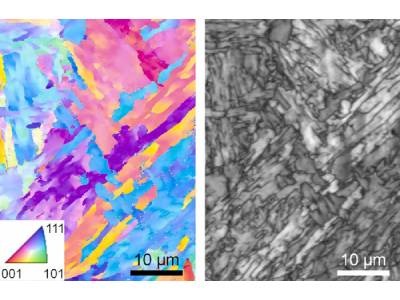
A microscopic image of 3D-printed 17-4 stainless steel. The colors in the left-side version of the image represent the differing orientations of crystals within the alloy. Credit: NIST
3D-printing technology can enable the manufacture of industrial parts and structures with increased flexibility and decreased costs compared to traditional manufacturing methods. However, some materials are more difficult to adapt to 3D-printing methods, leading to results that are inconsistent and do not match the desirable properties of the original material. A team of researchers from the National Institute of Standards and Technology (NIST), the University of Wisconsin-Madison and Argonne National Laboratory have managed to create a remarkably strong, 3D-printable version of 17-4 precipitation hardening (PH) stainless steel by using synchrotron X-ray diffraction (XRD) methods to finetune the composition of the alloy.
17-4 PH steel is one of the strongest stainless steels, is corrosion-resistant and is used as a material in structures ranging from airliners and cargo ships to nuclear power plants. One of the challenges of adapting this material to the 3D-printing process is the rapid and drastic temperature changes the material undergoes during manufacturing – sometimes with cooling rates greater than one million degrees Celsius per second, according to NIST physicist and study co-author Fan Zhang. The researchers aimed to steer the material to form a martensite crystal structure during printing; this martensite structure is what gives the material its highly-sought after properties. The team utilized XRD analysis at the Advanced Photon Source (APS), a 1,100-meter-long particle accelerator housed at Argonne National Laboratory, and observed how the structure of the alloy changed as it underwent 3D printing. The scientists found that changing the composition of the powdered metal used to produce the alloy resulted in different structural dynamics as the metal heated up, cooled and solidified.
The final composition of the 3D-printable 17-4 PH steel included iron, nickel, copper, niobium and chromium. Using a fine-tuned combination of these elements, the team produced a final 3D-printed product with a fully martensitic structure and similar strength to its conventionally produced counterpart, as confirmed by mechanical testing. Additionally, the researchers showed that their alloy consistently resulted in fully martensitic 17-4 PH steel over a wide range of cooling rates between 1,000 and 10 million degrees Celsius per second, Zhang said. Another benefit of new material is the formation of fine precipitates during the heat treatment portion of 3D-printing, which normally requires additional time and special equipment to induce during traditional 17-4 PH steel production. This research was published in Additive Manufacturing.
“Our 17-4 is reliable and reproduceable, which lowers the barrier for commercial use,” said study co-author Lianyi Chen, a professor of mechanical engineering at UW-Madison. “If they follow this composition, manufacturers should be able to print out 17-4 structures that are just as good as conventionally manufactured parts.”
The study also demonstrates the value of XRD-based analysis in optimizing alloys for 3D printing, which could extend beyond stainless steel and offer new avenues for producing high quality parts faster and at a lower cost.